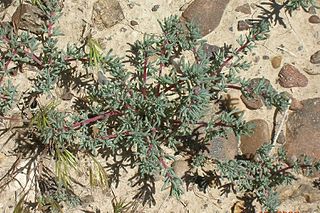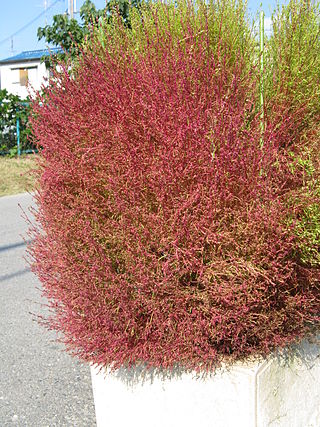
Halogeton glomeratus is a species of flowering plant in the family Amaranthaceae known by the common names saltlover, Aral barilla, and halogeton. It is native to Russia, Central Asia and China, but the plant is probably better known in the western United States, where it is an introduced species and a notorious noxious weed. This annual herb is a hardy halophyte, thriving in soils far too saline to support many other plants. It also grows in alkali soils such as those on alkali flats and disturbed, barren habitat. It can be found in sagebrush and shadscale habitat, and it grows well in areas with cold winters.

Kochia is a synonym of the genus Bassia, which belongs to the subfamily Camphorosmoideae of family Amaranthaceae.

Neokochia americana is a species of flowering plant in the amaranth family, subfamily Camphorosmoideae, known by the common name green molly.

Bassia scoparia is a large annual herb in the family Amaranthaceae native to Eurasia. It has been introduced to many parts of North America, where it is found in grassland, prairie, and desert shrub ecosystems. Its common names include ragweed, summer cypress, mock-cypress, kochia, belvedere, World's Fair plant, burningbush, Mexican firebrush, and Mexican fireweed, the provenance of the latter three names being the herb's red autumn foliage.
Neokochia californica is a species of flowering plant in the subfamily Camphorosmoideae of the amaranth family known by the common name rusty molly. It is native to the valleys and deserts of southeastern California and adjacent parts of Nevada, where it grows in dry, alkaline soils such as alkali flats and desert washes. This is a perennial herb or small shrub growing one or more sprawling, branching stems to a maximum height near 60 centimeters. The stems are lined with narrow, elongated, somewhat flattened fleshy leaves up to about a centimeter long. The leaves and stem are coated in grayish or brownish hairs. The inflorescence is made up of one or more tiny hairy flowers sprouting from the axils of the leaves.

Bassia is a genus of flowering plants in the family Amaranthaceae. They are distributed in the western Mediterranean to eastern Asia. Some occur outside their native ranges as introduced species.
B. californica may refer to:

Coleophora deviella is a moth of the family Coleophoridae. It is found from Denmark to Spain, Sardinia, Sicily and Greece and from Great Britain to southern Russia. It occurs in desert-steppe and desert biotopes.
Coleophora magyarica is a moth of the family Coleophoridae. It is found in Slovakia, Hungary, Ukraine, southern Russia and central Asia. It occurs in desert and semi-desert biotopes.
Coleophora charadriella is a moth of the family Coleophoridae. It is found in the Ural.
Coleophora tornata is a moth of the family Coleophoridae. It is found in southern Russia and central Asia. It occurs in desert-steppe and desert biotopes.
Coleophora eichleri is a moth of the family Coleophoridae. It is found in southern Russia and central Asia. It occurs in desert-steppe and desert biotopes.
Coleophora kargani is a moth of the family Coleophoridae. It is found in southern Russia and central Asia. It occurs in semi-desert biotopes.
Coleophora superlonga is a moth of the family Coleophoridae. It is found in Ukraine and southern Russia.
Coleophora remizella is a moth of the family Coleophoridae. It is found in Slovakia, Hungary, Romania, Bulgaria and southern Russia.
Coleophora tecta is a moth of the family Coleophoridae. It is found in Kazakhstan.
Coleophora izenella is a moth of the family Coleophoridae.

Camphorosmeae is a species-rich tribe of the Amaranthaceae, formerly Chenopodiaceae, with 20 genera and about 179 species. It is classified as a single tribe of subfamily Camphorosmoideae.

Bassia hyssopifolia is a species of flowering plant in the family Amaranthaceae, known by the common names five-horn smotherweed, five-hook bassia, and thorn orache. It is native to parts of Asia and Eastern Europe, and it is known on other continents as an introduced species, including North and South America and Australia. It is a weed, invasive at times.
This page is based on this
Wikipedia article Text is available under the
CC BY-SA 4.0 license; additional terms may apply.
Images, videos and audio are available under their respective licenses.








